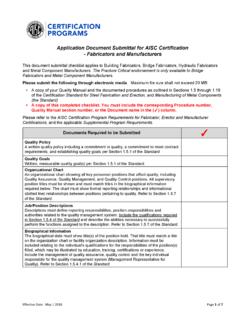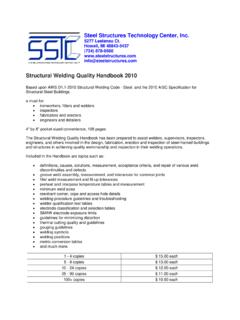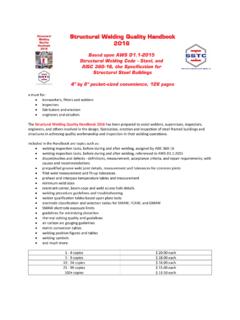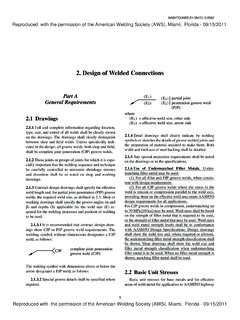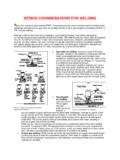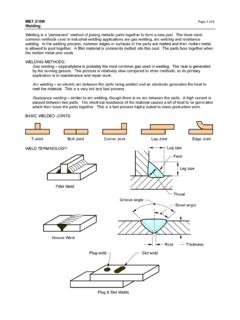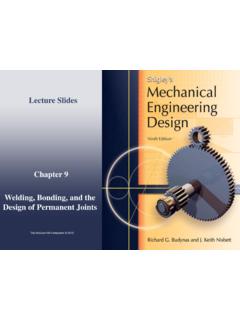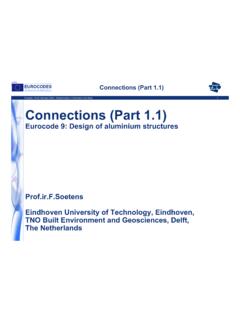Transcription of steelwise - AISC Home
1 January 2013 MODERN STEEL CONSTRUCTIONIt Is typIcally less expensive to use two-sided fillet welds instead of complete joint penetration (CJP) groove fillet weld , like a CJP groove weld , can be sized to develop the full strength of the connection plate in shear and/or ten-sion. When the engineer of record indicates a CJP groove weld ( , on a flange plate in a moment connection), it is possible for the fabricator to successfully substitute a fillet weld in the shop with approval from the EOR. In fact, the current AWS allows filled weld substitution (or PJP with fillet rein-forcement) automatically unless the EOR specifically requires a CJP groove weld (for more about this, see Tom Schlafly s article The New Groove weld System, 01/12). fillet Welds in shearAISC Specification Table provides the formula to calcu-late the nominal strength of a fillet weld as , where FEXX is the weld metal strength.
2 This is multiplied by the effec-tive area (Aw), which is the product of the effective length and the effective throat ( times the leg dimension, w). The design strength for LRFD is then obtained by multiplying by , and for ASD the allowable strength is then determined by dividing by . The following equations assume the weld is a two-sided fillet weld with a weld strength level FEXX = 70 ksi: ASD weld Strength per inch, V = 2 FEXX w / = w ASD Plate Shear Rupture Strength per inch, V = (Fu) t/ = (Fu) t /2 = Fu t ASD Plate Shear Yielding Strength per inch, V = (Fy) t/ = (Fy) t = Fy tLRFD calculations are similar and in the same relationship to each the CJP groove welds are made with matching-strength filler metal, the strength of a connection is governed or con-trolled by the base metal and no checks on the weld strength are required.
3 Thus, setting the fillet weld strength equal to the controlling plate strength, we find the following weld leg size required:Min ( Fu t, Fy t) = w Therefore, the required weld leg size is the lesser of Fu t and Fy t ASTM A36 plate, the size of the two-sided fillet weld must be times the thickness of the plate to match the strength of the plate. So, using this for T-joints loaded in shear (for example, web to flange welds in plate girders), we find that the fillet welds required to develop the web thickness can be sized as half the web plate weld dEsIgnBy Erik NElsoN, , , aNd EthaN tirrEllsteelwiseUsing fillet welds instead of CJP groove welds. Erik anders nelson is the owner of structures Workshop, inc., in Providence, , and teaches at the rhode island school of design and the Massachusetts institute of technology.
4 You can reach him at or you can visit and comment on his engineering blog at Ethan tirrell is a structural engineer with structures Workshop, inc. he can be reached at 1: weld in shear Figure 2: Plate Girders MODERN STEEL CONSTRUCTION january 2013steelwiseThese conditions are rarely loaded to a level that would necessitate the use of a CJP groove weld , but even so these welds are often specified by EORs, perhaps because it is a simple matter to call out a CJP groove weld . The economy of doing so is another matter, however, and the substitution of fillet welds often is more economical. In such cases, the fabrica-tor can propose the substitution of fillet welds for CJP groove welds (see Table 1) as a more economical option. fillet Welds in tension The phrase fillet welds in tension is technically incorrect but is used to compare the orientation of the weld to that of a CJP groove weld in tension.
5 fillet welds only work in shear, and it is better to describe this condition as welds perpendicu-lar to the load. fillet welds loaded perpendicular to their longitudinal axis have 50% greater strength than when loaded parallel. Until recently, this extra strength, based upon load angle, was often conservatively ignored ( , as in the AISC ASD Manual, 9th Edition examples). More recently, AISC examples and actual practice have tended to take advantage of this directional strength strength of a linear weld group loaded in-plane through the center of gravity is the following: Fw = FEXX ( + ) Fw = FEXX ( ) for welds perpendicular to loading where, = angle of loading measured from the weld longitudinal axis (degrees)Therefore, we can rewrite the equations for tension on the plate and a 50% increase in the weld strength.
6 The following equations assume the weld is a two-sided fillet weld with a weld strength level FEXX = 70 ksi: ASD weld per inch, T = 2 FEXX w / = w ASD Plate Tension Rupture Strength per inch, T = (Fu) t/ = (Fu) t /2 = Fu t ASD Plate Tension Yielding Strength per inch, T = (Fy) t/ = (Fy) t = Fy tLRFD calculations are similar and in the same relationship to each the fillet weld strength equal to the plate strength (or CJP groove weld strength), we find the following: Min ( Fu t, Fy t) = wTherefore, the required weld leg size is the lesser of Fu t and Fy t For ASTM A36 plate, the size of the two-sided fillet weld must be times the thickness of the plate to match the strength of the fillet weld substitution can often be made for CJP groove welds in tension, such as for bolted moment connections where flange plates are welded to the column (W-shape or HSS col-umns).
7 Due to the significant time and preparation required for CJP groove welds, a fillet weld alternative would be preferred by most fabricators. Why are two-sided fillet welds not used more in moment connections? Sometimes it is a matter of fit-up (especially in the field). If the joint is open, the weld size adjustments for fil-let welds may erase the potential economy. When fit-up is not a problem, it is likely that engineers use typical moment connec-tion details that have not changed since AISC began to recognize the 50% strength increase for fillet welds in this orientation. A strict reading of AISC specifications before 2010 will show that the increase actually was applicable only to in-plane loading cases. However, this limitation was rarely applied because fillet welds usually have an orientation that can be said to align with a plane of the joint.
8 To eliminate the confusion, and after confir-mation by testing, the 2010 AISC Specification no longer has the in plane requirement, and a two-sided fillet weld is officially a viable option for plated moment connections. It must also be recognized that it is simply easier for an engineer to indicate a CJP weld that will develop the strength of the plate without hav-ing to perform any calculations again, construction economy aside. The tables presented here may help in this , there are limitations to the use of fillet welds in moment connections. Since the position of welding must be considered, the fillet weld option may not be feasible for directly welded beam flange moment connections. The two-sided joint detail would require overhead welding, and this may not be practical or more economical.
9 Also, it should be noted that fillet welds cannot be used in place of CJP groove welds for high-seismic applications (building structures with R > 3, for example) without careful consideration of the requirements of the AISC Seismic 3: weld in tension WtyPCJP - tyPoRFigure 4: Moment Connections MODERN STEEL CONSTRUCTION january 2013steelwiseASTM A36 SteelASTM A992 or A572 Grade 50 Steeltwo-sided fillet weld in shear ( weld Parallel with force)w = 1/2 t(or w = t)w = 11 16 t(or w = t)two-sided fillet weld in tension ( weld perpendicular to force)w = 1/2 t(or w = t)w = 11 16 t(or w = t)two-sided fillet weld on single-Plate shear Connections (per aisC Manual)*w = 5 8 tw = 5 8 tthe Right sizeWe have found that the easiest way to do these calculations is to have the fillet weld size expressed as a fraction of the plate thickness (much like what is done with the w = 5 8 t provision for single-plate shear connections in the AISC manual).
10 Table 1 summarizes the different configurations and allows the user to easily determine the required fillet weld size on each side of the element instead of specifying a CJP groove weld . Surprisingly, we found that the required weld size is dependent only on the plate strength and is not affected by the weld orientation. This is due to the use of the directional strength can be significant cost savings using a two-sided fil-let weld in lieu of a CJP groove weld . One cost benefit is that fillet welds can reduce weld metal volume, although shop CJP groove welds can be configured such that the weld volume is not significantly increased over fillets ( , by using details with two-sided bevel preparation). There is additional time associ-ated with CJP groove welds, such as beveling of the joints and removing the weld tabs and backing.





